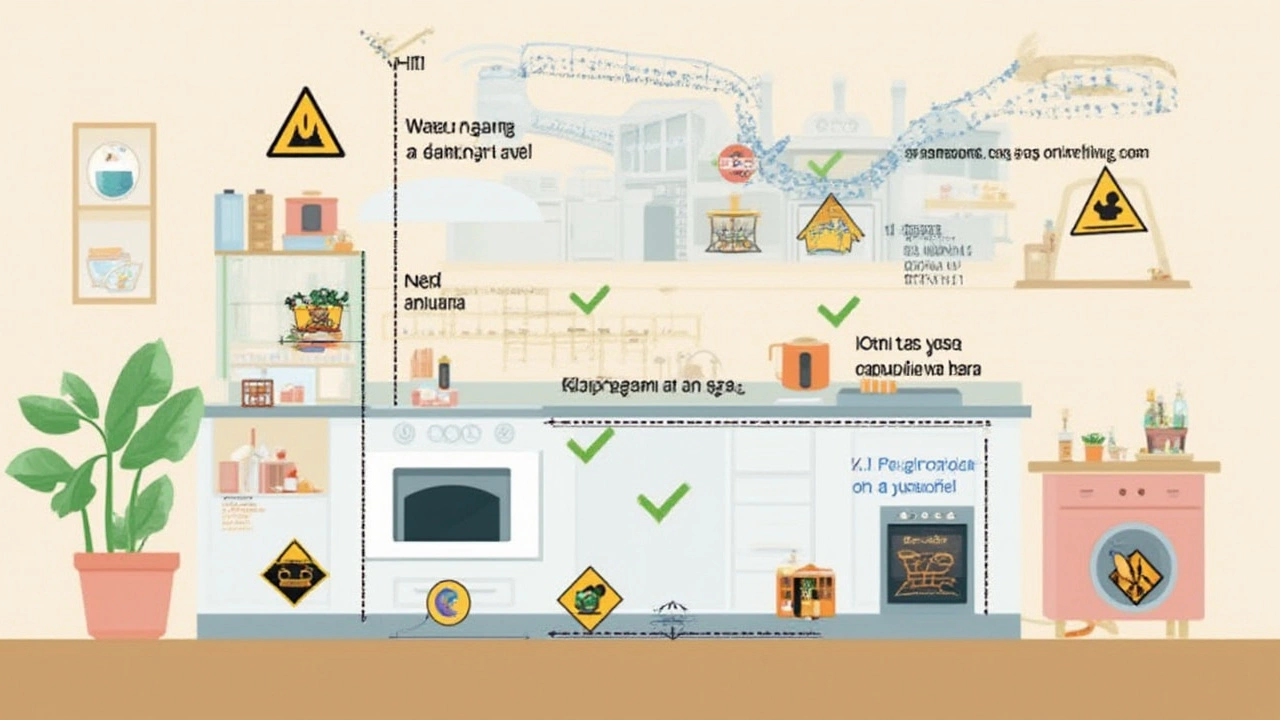
I’ve come home more than once to find my son Soren’s attempt at a sandwich still spinning inside our microwave, ticking away without a care for where it’s actually plugged in. Truth is, putting a microwave 'anywhere' sounds like freedom, but the reality is trickier. Sure, microwaves are more portable than ovens, but tossing one anywhere—say, on the living room end table or wedged between stacks of laundry—can backfire in wild ways. Ever heard of a microwave making fire alarms scream at a sleepover? I have, and the story’s got more to do with placement than the leftover pizza inside.
Microwaves Need Power and Venting: Don’t Skip the Basics
I get it. Sometimes you just want the easiest reach—like mounting your microwave low for the kids or tucking it into a spare cabinet. First rule: microwaves gobble up more power than you might expect. Typical models chew through 800 to 1200 watts. Many kitchen outlets can handle this load, but it’s risky to share a single outlet with big energy hogs like toasters or coffee machines. If you’ve ever tripped a breaker making popcorn, you know what I mean. The National Electrical Code has updated recommendations on dedicated circuits—one for just the microwave. So before hauling your unit to some far corner, check if there’s a steady, strong power source without extension cords—the latter can overheat and spark.
Next, there’s ventilation. Most microwaves, especially the over-the-range variety, need breathing room. That’s not just to keep them running but to avoid cooking you out with heat or, worse, frying their own electronics. Built-in models usually have vents that route air back into your kitchen or, if you’re lucky, outside. Poor air flow? That means smoke from heated butter or last night’s chili just lingers—and some microwaves might even shut off to protect themselves from overheating.
One well-done study by Consumer Reports found that microwaves placed in tight, unventilated shelves tend to break down faster—by almost 40% compared to those with at least 3 inches of space around them. For countertop microwaves, leave 3 inches at the top and back for airflow. If you’re relying on the microwave’s built-in vents to clear steam and smells, check that their filters aren’t clogged up with months-old lasagna gunk.
| Microwave Type | Ventilation Needs | Power Usage (Watts) |
|---|---|---|
| Countertop | Leave 3" at back/top; avoid closed cabinets | 800-1200 |
| Over-the-range | Venting to outside preferred; recirculating needs clean filters | 900-1100 |
| Built-in/Drawer | Professional install; follow spec for clearance | 950-1200 |
Choosing the Right Spot in Your Kitchen (or Elsewhere)
If you’re redesigning your kitchen or fighting for counter space, think about who uses the microwave and how. I have short kids—Soren can barely see above the countertop—so tucking the unit into a low drawer sounds nice, but only if it’s still easy to open and close, and all cords are properly hidden. Putting a microwave on a high shelf? Not so smart unless you love scrubbing chili from the ceiling. Accessibility matters.
Convenience is a big factor: are you reheating coffee all day, or mostly defrosting dinner for a big family? Microwaves work best close to work zones—the sink, the fridge, prep surfaces—so you’re not trekking hot soup across the kitchen.
Cabinet installation is tempting for a neat look. However, you have to pay attention to depth and ventilation specs. Many modern kitchens use trim kits for built-in microwaves, which let air circulate and stop the unit from overheating. Stack your microwave above the oven? That needs extra bracing for weight. Go with an island install? Make sure there’s a safe way to run power and not have cords snaking where people walk.
There’s also the wild-card spots: the garage for late-night snacking, the home office, or even the backyard bar. In those cases, check humidity and dust—microwaves aren’t fond of moisture or insects. My buddy ruined one by running it in an uninsulated shed—condensation got inside, and the circuit board fizzled.
Placement isn’t only about physical space. According to the U.S. Fire Administration, about 9% of household cooking fires start with microwaves. Most issues? Blocked vents, overloaded outlets, or the microwave sitting somewhere you can’t keep an eye on. So pick a spot you can reach fast, with a fire extinguisher close by.

Hidden Hazards: What You Must Avoid
It’s easy to overlook what could go wrong if you wedge a microwave next to your vintage kettle collection. For starters, stacking stuff on top seems like an innocent solution—especially if you’re low on space. Don’t. Microwaves get warm, and the vents are often on top or sides. Toss books, towels, or a breadbox up there, and you’re risking blocked fans or even a fire. I saw an insurance claim last year after a tea towel smoldered after sliding off a high shelf and onto a hot vent.
Microwave cords are another landmine. Extension cords look like an answer, but they rarely handle a microwave’s draw safely. Most fire codes recommend plugging directly into a grounded wall outlet. Stringing a cord along the countertop just begs for someone—preferably a kid chasing the dog—to yank the whole thing onto the floor.
If you’re tempted to try a microwave in the bathroom or laundry area, think twice. Steam, wet hands, and appliances with heavy wattage don’t play nice together. Bathrooms have special GFCI (ground-fault circuit interrupter) outlets for a reason. If the microwave trips one, that’s a red flag it doesn’t belong there.
Never cover or block the microwave’s interior light or fan. The fan pulls out hot air every time you nuke your coffee. Blocking this can cause the microwave’s circuits to overheat and kill the magnetron, which is what actually cooks your food. If you notice odd noises or the microwave getting too hot to touch, unplug it and call a technician.
Smarter Microwave Ideas: Make It Work for Your Family
If you want to get creative, there are plenty of clever ways to make a microwave fit your needs without bending the rules on safety or performance. Try a microwave cart or a movable island—they do more than just make space; you can hide the cord and add some extra storage underneath for those three million bags of popcorn my daughter Annelise insists on buying. Some newer microwaves even have child-safety locks, so the smallest hands can’t prank you by melting crayons at snack time.
Drawer-style microwaves have boomed in popularity for families, landing right at counter height and letting gravity, not aching shoulders, guide hot bowls out. They cost a bit more, but they’re safer for kids and folks who don’t want to wrestle with heavy dinner plates overhead.
Another trick—install an under-cabinet microwave using brackets. The bottom must still be a safe distance above cooktops, usually at least 18 inches. Built-in lights underneath do double duty as task lighting. If you’re a late-night snacker, tucking a microwave into a walk-in pantry with a dedicated outlet lets you keep kitchen counters clean (and keeps the device near cereal boxes—trust me, that “late night microwaved apple pie” phase is coming for your kids too).
- Use surge protectors only if they’re rated for microwaves—many aren’t.
- Label the outlet so family and guests know it's for the microwave only.
- If you clean your microwave weekly, pop out and rinse the filters. Replace every 6 months.
- For tight spaces, tape a cardboard template of the microwave and test doors/drawers before committing.
- Consider the door swing—microwave doors need extra room on one side, especially in corners.
Be smart about replacing an old unit: models over 10 years old are much more prone to leaks or inefficient heating, and replacement parts are pricey. Check local recycling rules, because some places require microwaves to go to electronics recycling (their capacitors can hold charge and be dangerous if thrown in the trash).

Final Thoughts—Is ‘Anywhere’ Actually Anywhere?
You can’t just stick a microwave wherever inspiration (or lack of counter space) strikes. Want it to work flawlessly, not set off smoke alarms, and last for years? Then focus on the basics: enough power, proper venting, and open, easily controlled space. Microwave placement isn’t just about looking tidy—it’s about safety, performance, and keeping meals rolling without a side of electrical drama. I’ve moved mine more times than I can count (army brat roots run deep), and every time, it came down to practical choices: where the kids could reach, where I wouldn’t mess with outlets, and how the kitchen actually flowed. Take a few extra minutes to do it right, and you’ll save yourself melted lights, burnt popcorn smells, and that frantic dash to the breaker in the dark.